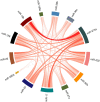A systemic approach to screening high-throughput RT-qPCR data for a suitable set of reference circulating miRNAs
- PMID: 32005151
- PMCID: PMC6995162
- DOI: 10.1186/s12864-020-6530-3
A systemic approach to screening high-throughput RT-qPCR data for a suitable set of reference circulating miRNAs
Abstract
Background: The consensus on how to choose a reference gene for serum or plasma miRNA expression qPCR studies has not been reached and none of the potential candidates have yet been convincingly validated. We proposed a new in silico approach of finding a suitable reference for human, circulating miRNAs and identified a new set of endogenous reference miRNA based on miRNA profiling experiments from Gene Expression Omnibus. We used 3 known normalization algorithms (NormFinder, BestKeeper, GeNorm) to calculate a new normalization score. We searched for a universal set of endogenous miRNAs and validated our findings on 2 new datasets using our approach.
Results: We discovered and validated a set of 13 miRNAs (miR-222, miR-92a, miR-27a, miR-17, miR-24, miR-320a, miR-25, miR-126, miR-19b, miR-199a-3p, miR-30b, miR-30c, miR-374a) that can be used to create a reliable reference combination of 3 miRNAs. We showed that on average the mean of 3 miRNAs (p = 0.0002) and 2 miRNAs (p = 0.0031) were a better reference than single miRNA. The arithmetic means of 3 miRNAs: miR-24, miR-222 and miR-27a was shown to be the most stable combination of 3 miRNAs in validation sets.
Conclusions: No single miRNA was suitable as a universal reference in serum miRNA qPCR profiling, but it was possible to designate a set of miRNAs, which consistently contributed to most stable combinations.
Conflict of interest statement
The authors declare that they have no competing interests.
Figures







Similar articles
-
Reference miRNAs for miRNAome analysis of urothelial carcinomas.PLoS One. 2012;7(6):e39309. doi: 10.1371/journal.pone.0039309. Epub 2012 Jun 20. PLoS One. 2012. PMID: 22745731 Free PMC article.
-
Identification of suitable plasma-based reference genes for miRNAome analysis of major depressive disorder.J Affect Disord. 2014 Jul;163:133-9. doi: 10.1016/j.jad.2013.12.035. Epub 2014 Jan 2. J Affect Disord. 2014. PMID: 24479999
-
MicroRNA Expression Profiling to Identify and Validate Reference Genes for the Relative Quantification of microRNA in Rectal Cancer.PLoS One. 2016 Mar 3;11(3):e0150593. doi: 10.1371/journal.pone.0150593. eCollection 2016. PLoS One. 2016. PMID: 26937645 Free PMC article.
-
Reference miRNAs for colorectal cancer: analysis and verification of current data.Sci Rep. 2017 Aug 21;7(1):8413. doi: 10.1038/s41598-017-08784-3. Sci Rep. 2017. PMID: 28827728 Free PMC article.
-
[miRNA-16 AS an Internal Control in Breast Cancer Studies: A Systematic Review and Meta-analysis].Mol Biol (Mosk). 2021 Nov-Dec;55(6):1045-1056. doi: 10.31857/S0026898421060136. Mol Biol (Mosk). 2021. PMID: 34837708 Russian.
Cited by
-
Circulating non-coding RNAs as a diagnostic and management biomarker for breast cancer: current insights.Mol Biol Rep. 2022 Jan;49(1):705-715. doi: 10.1007/s11033-021-06847-3. Epub 2021 Oct 22. Mol Biol Rep. 2022. PMID: 34677714 Review.
-
The Value of Serum MicroRNA Expression Signature in Predicting Refractoriness to Bortezomib-Based Therapy in Multiple Myeloma Patients.Cancers (Basel). 2020 Sep 9;12(9):2569. doi: 10.3390/cancers12092569. Cancers (Basel). 2020. PMID: 32916955 Free PMC article.
-
miRNA and lncRNA Expression Networks Modulate Cell Cycle and DNA Repair Inhibition in Senescent Prostate Cells.Genes (Basel). 2022 Jan 24;13(2):208. doi: 10.3390/genes13020208. Genes (Basel). 2022. PMID: 35205253 Free PMC article.
-
Identification of miR-4644 as a suitable endogenous normalizer for circulating miRNA quantification in hepatocellular carcinoma.J Cancer. 2020 Oct 17;11(23):7032-7044. doi: 10.7150/jca.48903. eCollection 2020. J Cancer. 2020. PMID: 33123293 Free PMC article.
-
A Translational Model to Improve Early Detection of Epithelial Ovarian Cancers.Front Oncol. 2022 Apr 21;12:786154. doi: 10.3389/fonc.2022.786154. eCollection 2022. Front Oncol. 2022. PMID: 35530324 Free PMC article.
References
-
- Avery OT, Macleod CM, McCarty M. Studies on the chemical nature of the substance inducing transformation of pneumococcal types: induction of tranformation by a desoxyribonucleic acid fraction isolated from pneumococcus type III. J Exp Med. 1944;79(2):137–158. doi: 10.1084/jem.79.2.137. - DOI - PMC - PubMed
-
- Lehman IR, Bessman MJ, Simms ES, Kornberg A. Enzymatic synthesis of deoxyribonucleic acid. I. Preparation of substrates and partial purification of an enzyme from Escherichia coli. J Biol Chem. 1958;233(1):163–170. - PubMed
-
- Higuchi R, Fockler C, Dollinger G, Watson R. Kinetic PCR analysis: real-time monitoring of DNA amplification reactions. Biotechnology (N Y) 1993;11(9):1026–1030. - PubMed
MeSH terms
Substances
LinkOut - more resources
Full Text Sources
Other Literature Sources

